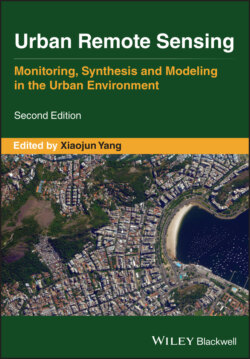Читать книгу Urban Remote Sensing - Группа авторов - Страница 20
1.3.1 SENSORS AND SYSTEMS FOR URBAN AREAS
ОглавлениеWith six major chapters, this part (Part II) discusses several advanced and emerging platforms or systems, such as unmanned aircraft systems and social sensing, which provide new opportunities advancing urban studies. It begins with Chapter 2 discussing an effort to examine urban built‐up volume through three‐dimensional analyses with lidar and radar data. It was motivated by the importance of the vertical dimension in urban built‐up areas but the lack of such information from conventional image‐based analyses. The authors used spaceborne radar data to monitor built‐up volume that was further validated with lidar data. They also discuss the future extension of high‐resolution multiple satellite SARs in quantifying urban build‐up volume.
Unmanned aircraft systems (UAS) platforms represent a new frontier of remote sensing applications. Chapter 3 discusses the utilities of UAS for urban remote sensing research. It introduces the concept of UAS, some common types of UAS models and cameras onboard, and a typical UAS data collection procedure. Several urban applications are discussed, along with a case study to demonstrate how UAS can be used for 3D mapping of urban structures. Finally, the authors discuss some major challenges of using UAS for urban studies, which are related to regulations, operations, and data processing.
Big geotagged‐data from mobile phones, social media, vehicle trajectories, and street views offer new opportunities for understanding human behaviors and characteristics of cities. The remaining four chapters in this part focus on social sensing. Chapter 4 reviews various analytical methods, such as temporal signature analysis, text analysis, and image analysis, for social sensing research. These methods support a variety of applications such as estimating urban vibrancy, formalizing place semantics, and modeling intra‐urban human mobility patterns. Chapter 5 reviews the utilities of ground‐based street view images for urban remote sensing research. It introduces some recently developed methods, algorithms, and applications using street view images, along with several research projects as related to street greenery mapping, urban form analysis, and urban thermal environment modeling. Chapter 6 discusses the usefulness of social media outlets such as Twitter for geographic research on human activities in urban areas. The authors examine the spatial distribution of city tweets and their densities and suggest that natural cities and their topological centers characterized by tweet densities are better than conventional cities and city centers as defined with census units for geographic research. This research indicates that tweet densities can be a good surrogate of population densities. The last chapter (Chapter 7) in this part discusses the potential of integrating remote sensor data with location‐based social media to examine socioeconomic dynamics. The authors specifically consider satellite imagery of nighttime light (NTL) brightness and the geotagged Twitter posts and discuss the challenges in combining the two types of heterogeneous data. They further develop a practical approach to integrate them in order to derive a reliable socioeconomic indicator.
